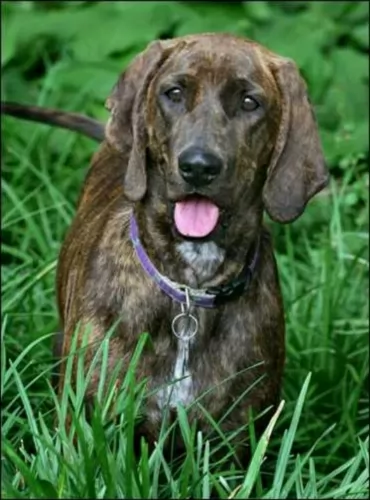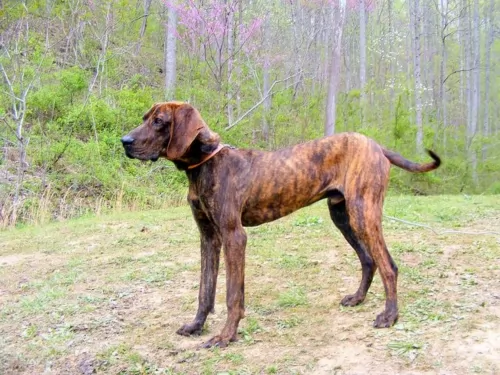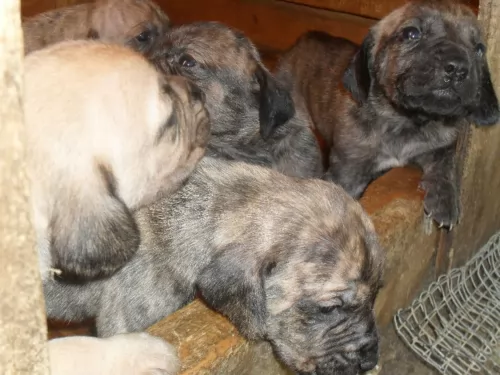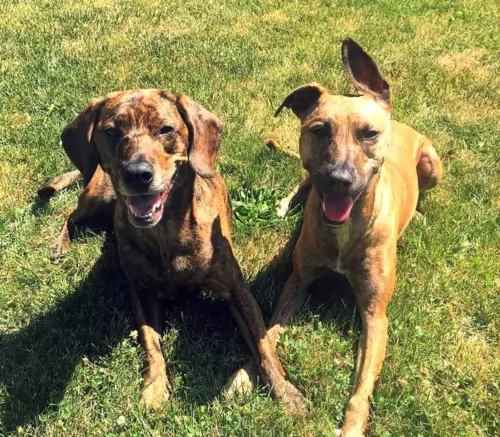 MyDogBreeds
MyDogBreedsPlott Hound is originated from Germany but Mixed is originated from United States. Plott Hound may grow 39 cm / 15 inches shorter than Mixed. Plott Hound may weigh 85 kg / 187 pounds lesser than Mixed. Plott Hound may live 6 years less than Mixed. Both Plott Hound and Mixed has almost same litter size. Plott Hound requires Low maintenance. But Mixed requires Moderate maintenance
 The Plott Hound is a scent hound who has always been used for for hunting bears. The dog may well be the state dog of North Carolina, but it isn’t well known.
The Plott Hound is a scent hound who has always been used for for hunting bears. The dog may well be the state dog of North Carolina, but it isn’t well known.
The Plott Hound is an old dog breed descending from several Hanoverian Schweisshunds which were brought to North Carolina way back in 1750. They were brought by a German immigrant, Johannes George Plott, and that is why it is believed that the dog hails from Germany.
It is believed that in the early 1900s the dog was mated with black-and-tan hounds, giving the canine additional scenting skills as well as its black-saddled brindle pattern. The dog breed has since been registered by the United Kennel Club and is also registered by the American Kennel Club.
Many people are inclined to think that mixed breed or cross-breed dogs, also known as mutts or mongrels or designer dogs are just pavement specials. They think they look nothing much better than junkyard mutts.
This may be so, but not always, and these mixed breed dogs always seem to have hearts of gold. A Mixed breed is a dog that has parent’s who aren’t registered and who come from different breeds. In other words the parents aren’t of the same breed.
Guessing a cross breed’s ancestry can be difficult as these mixed-breeds have more genetic variation than pure breeds. They've been around since ancient times. The dogs originate in different countries and they all have different coats, different sizes and different temperaments.
It is sad but true – there are literally millions of mixed dogs worldwide, some of which never know what it is to live with- and be lovingly cared for by a human being.
 The Plott Hound is a large dog standing between 50 and 71cm in height, both male and female, and weighing in at between 18 to 27kg.
The Plott Hound is a large dog standing between 50 and 71cm in height, both male and female, and weighing in at between 18 to 27kg.
The dog’s coat is available in a number of brindle shades such as red-, blue, tan-, brown and black brindle. The ears of the dog are long and floppy and the tail is also long and held up or down, depending on whether the dog is quiet or excited. He is active and would not be recommended for a small homes in the city.
Bold, alert and intelligent, the Plott Hound is a confident, courageous and loyal pet, being somewhat aloof around strangers.
Typical of any hounds, he is a strong willed, independent dog, and this is why he will need training and socialization. These make him obedient so that he can respond to simple commands such as sit, lie down, come and stay. This makes him a pleasure to have around wherever you go with him. He is also protective, making him an excellent watchdog.
Sometimes Mixed dog breeds come about from two dogs meeting on the streets and mating or it could be two pure-breeds accidentally mating, resulting in a mixed breed.
The mixed breed dog puppy could inherit looks from just the one purebred parent so that he grows up looking like a pure-breed. With a cross breed the standard for breeding isn’t the same for purebreds where the appearance and temperament is more or less the same.
A mixed breed dog doesn’t have these standards to conform to and they are as varied and unique as the colors in the rainbow. It’s not possible to know what a mixed breed dog’s puppies will look like. A typical example of a mixed breed is a Labradoodle. People love the temperament of the Labrador but they want the low shedding qualities of the Poodle as well.
Mixed breed dogs can be small or large and that means different litter sizes. If you don’t want your Mixed dog breed becoming a parent, you can spay or neuter your dog.
There are many people who avoid choosing a ridiculously high priced pure breed puppy and they prefer to choose a mixed breed. This is partly because these mixed breed dogs are healthy, resilient and nearly always a good match for you and your family.
 The Plott is a bold, aggressive type of dog, but he is also loving, loyal and intelligent.
The Plott is a bold, aggressive type of dog, but he is also loving, loyal and intelligent.
If you want him as a pet and companion, another bonus part is that his smooth, short coat makes him a low maintenance breed. He’s good looking too, and with training and socialization he’s going to make a great family friend, guardian and pet.
Doesn’t matter what your Mixed breed dog looks like – he is a unique individual and you can never really predict what kind of a character he will turn out to be.
He might inherit a bit of placid behavior from one parent and a bit of clownish behavior from the other. It’s what makes them so special.
Ask most dog lovers who have owned a mixed breed and you will usually hear them say that they wouldn’t trade their amazing loyal and devoted pet for all the money in the world.
 Your Plott Hound is a healthy dog breed and can live to be anything from 12 to 14 years of age. Just like with any other dog breed, they are prone to certain health conditions. It is however, highly unlikely that he will get any of the diseases, but it is good to be aware of some of them -
Your Plott Hound is a healthy dog breed and can live to be anything from 12 to 14 years of age. Just like with any other dog breed, they are prone to certain health conditions. It is however, highly unlikely that he will get any of the diseases, but it is good to be aware of some of them -
There are many forms of cancer and some of the symptoms of the disease include lumps, sores that won’t heal, difficulty with breathing, lack of energy and black stools. Cancer is of course life threatening and treatments will include the likes of chemotherapy, radiation and even surgery.
This is also a deadly disease where parasites infect a dog’s heart and arteries. With a mosquito bite, dogs are exposed to larvae, and if left unchecked, the larva can develop into large worms. Your dog will be coughing, be lethargic and in a run down state. This disease certainly requires veterinary intervention.
There are so many things that can cause your dog to vomit and also have diarrhea. Eating the wrong foods, having an infection such as parvo for instance can cause a dog to vomit. An isolated case of vomiting needn’t be cause for alarm, but if your dog is vomiting repeatedly, you’ll need to get him to the vet.
This is more common in small dogs, but big dogs can easily become obese too. Being overweight has a host of negative health effects on your dog such as opening up diseases such as diabetes and putting too much stress on the joints.
All dogs, whether pure breeds or mixed breeds, need to be excellently cared for. When you consider the unconditional love your dog gives you, you want to ensure that you’re kind and loving towards him.
Every dog can be prone to common dog illnesses and there are some genetic predispositions for dogs with certain breeds within them.
All dogs can battle with problem teeth, but it appears to be more rife with smaller dogs. Dental disease starts with tartar build-up and when it isn’t removed from the teeth it progresses towards infection of the gums and teeth.
What you need to know is that not caring for the teeth can mean your pet losing his teeth but also putting your dog in danger of joint disease and problems with the kidneys and heart.
Obesity is a huge factor in small- and large dogs and can pave the way for other diseases with your pet. Being obese can shorten the life of your pet because it contributes to heart disease, digestive disorders, back pain and joint problems.
Fleas, ticks, mites and worms can play havoc with the health of your pet. Some of these parasites can then be transmitted from your pet to you. Parasites can cause pain, weight loss and even death for your pet so it is important to be vigilant in these matters.
Bloat, when the stomach twists and fills with gas as well as cancer and heart disease are just some of the more common diseases to look out for.
 The Plott is a hunting dog, used to being outside and used to being active and busy. For anyone who can satisfy his need to be busy, he’ll make a fantastic pet, companion and watchdog. Provide him with a variety of activities to keep him occupied – a walk, ball games, runs in the park, swimming and hikes.
The Plott is a hunting dog, used to being outside and used to being active and busy. For anyone who can satisfy his need to be busy, he’ll make a fantastic pet, companion and watchdog. Provide him with a variety of activities to keep him occupied – a walk, ball games, runs in the park, swimming and hikes.
Your Plott Hound has a short coat which sheds. He is regarded as a low maintenance dog and will require a brush twice a week. A rubber curry will keep the coat gleaming.
Check inside his ears for redness which can be indicative of an ear infection. Check his eyes too and make sure they are bright, clear and alert.
Trim your pet’s nails.
If you don’t intend to go in for breeding, have your dog neutered or spayed to avoid unwanted pups.
Provide your dog with a nice warm, dry place to sleep. When he goes outside, ensure he has both shade and sunshine to lie down in.
Make sure you feed your Plott Hound high quality food to promote longevity and good health. There are some commercially manufactured dog foods that have bad ingredients in them which can actually make your pet sick. Buy a quality food, and try to add in some homemade food too from time to time. You don’t have to make feeding your dog a complicated affair – some chopped up boiled chicken, brown rice or pasta and some vegetables such as sweet potato, carrots and spinach will keep your pet healthy and happy. You can add it into his kibble once in a while for a treat and also give him a little bit of raw meat occasionally. Easy, simple and nutritious – just like your pet wants. He doesn’t want you popping chocolate, raisins, peanuts, coffee and spicy foods into his mouth or bowl as it upsets his stomach.
Make sure he always has access to fresh, cool water.
Good nutritious food, exercise, grooming, a dry place to sleep, taking your pet to the vet when he is sick as well as plenty of love and attention will ensure your Mixed dog breed’s health and happiness.
Keep die diet of your pet simple and consistent to avoid digestive problems. Quality commercially manufactured food is a good choice. Boiled chicken, brown rice and cooked or raw vegetables will be excellent added into your dog’s kibble from time to time. Add in some raw meat occasionally as it is good for warding off skin diseases.
Exercise your pet regularly, but don’t overdo it with young dogs as it can lead to joint problems later on in life.